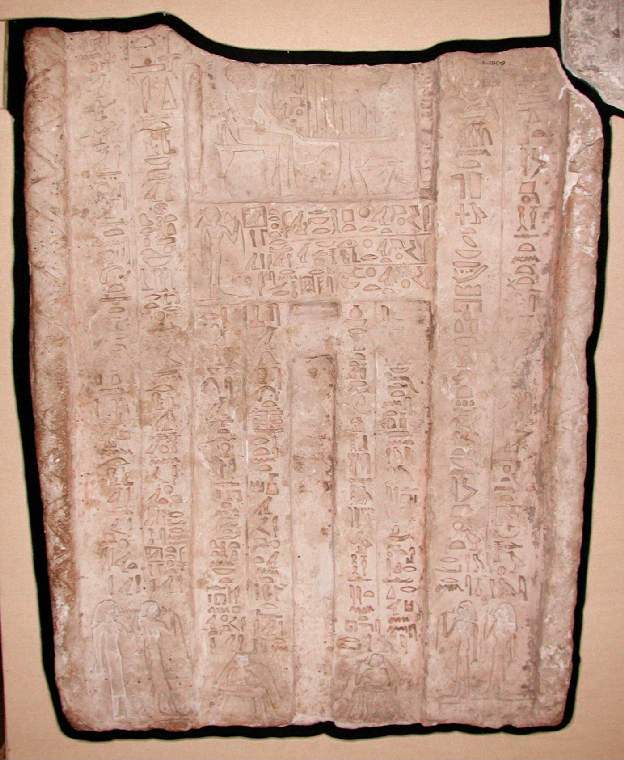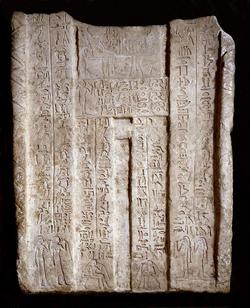Current Location: Exhibition: Exhibition: Made in Ancient Egypt, 3 October 2025 – 12 April 2026 (Adeane Gallery)
Titles
Limestone false door stela
Entities
Categories
Description
Limestone stela in the form of a false door belonging to a woman named Hemi-Ra. The door comprises two pairs of door jambs inscribed with vertical columns of hieroglyphic text, a lintel, or crossbar, with horizontal rows of hieroglyphic text and a rectangular panel with apertures at the top which is broken, but would have once been T-shaped. There is also a narrow, central niche in the middle of the door and a drum at the top (just below the lintel). The top part of the door is missing, but would have originally comprised a cavetto cornice with torus moulding and upper lintel. Hemi-Ra is shown multiple times on the door and past scholarly literature, particularly by Henry Fischer (1976), has suggested that the figures represent the female owner at three different phases of her life: as a young girl (the seated figures at the bottom of the inner jambs), a woman 'in her prime' (on the lintel and central panel) and as an older woman with frontal, drooping breasts (on the outer jambs). However, interdisciplinary research undertaken by the Fitzwilliam Museum between 2019 and 2021 indicates that the stela has been modified, probably at least twice. This is evident through changes in patina in the stone, tool marks and deeper carving in two key areas of the door - the central panel, and all of the upper bodies and the whole proper right outer figure of the figures depicted at the bottom of the jambs. These areas are also devoid of any red pigment, while red pigment can be detected elsewhere on the door - suggesting the door was once completely painted red to imitate the more expensive stone granite, and that the re-carving took place at some point after the pigment had faded. The pose and attire of the figures at the bottom of the door, which are more normally associated with male figures, is also suggestive that the door was originally carved for a man.
In terms of the door's provenance, Fischer attributes the door to Busiris in the Nile Delta based on the epithet 'one revered of Hathor, the lady of Busiris'. However, examination of this title in association with the other inscriptions, and the door's architectural and stylistic properties, would point to a provenance of the Memphite nome instead.
Publication of this stela is currently underway. For more information, see also: https://beta.fitz.ms/objects-and-artworks/highlights/E16909
Legal notes
Bought by Frederick William Green from Michel Casira, 1909
Measurements and weight
Height: 82.5 cm
Thickness: 8 cm
Width: 63.5 cm
Acquisition and important dates
Method of acquisition: Bought
(1909)
Dating
9th Dynasty
10th Dynasty
First Intermediate period
-2170
BC
-
-2025
BC
Project
Materials used in production
Limestone
Techniques used in production
Carved
Inscription or legends present
Inscription present: vertical text, hieroglyphs facing to right
- Text: Htp di nsw in wsir nb Ddw t Hnqt xt nb(t) wabt prrt Hr sAT n wsir m Ddw n imAXt Hmi-ra rn.s nfr rxt nsw Hm(t) nTr Hwt-Hr Hmi i anxw tpyw tA swAt.sn Hr wAt tn Ddt.sn t wAb pw n wsir iw n imAxtwy Hmi
- Location: Left jambs
- Method of creation: Incised
- Type: Inscription
Inscription present: vertical text, hieroglyphs facing to left
- Text: [Htp di] inpw xnty sH nTr imy wt nb tA Dsr prt-xrw m wAg-Hb DHwty-Hb n imAxwt Hmi-ra rn.s nfr Hmi [ink iri] Htp sbi imAxHsyt nt it.s //rt [mut].s imAxt nt Hwt-Hr nbt Ddw
- Location: Right jambs
- Method of creation: Incised
- Type: Inscription
Inscription present: hieroglyphs facing to right
- Text: imAxwt Hmi
- Location: Offering scene, in front of deceased
- Method of creation: Incised
- Type: Inscription
Inscription present: 3 horizontal rows of hieroglyphs facing to the right
- Text: imAxwt xr ptH skr imAxwt xr wsir nb Ddw imAxwt xr inpw nb qrst
- Location: Panel below offering scene
- Method of creation: Incised
- Type: Inscription
Inscription present: hiergolyphs facing to right
- Text: rxt nsw Hm(t) nTr Hwt-Hr Hmi-ra rn.s nfr Hmi
- Location: Panel below offering scene
- Method of creation: Incised
- Type: Inscription
Inscription present: vertical columns of hieroglyphs facing to right
- Text: sDA.s Hr wAwt nfr(w)t nt Hrty-nTr m imAxwt nt nTr-aA Hmi-ra rn.s nfr Hmi ir sS nb swAt.f Hr is pn Ddt.f t Hnqt n nbt is pn imAxt (Hmi-ra rn.s nfr Hmi)
- Location: Central jambs, left
- Method of creation: Incised
- Type: Inscription
Inscription present: vertical columns of hieroglyphs, facing to left
- Text: ink rdit t n Hqr Hbs n Hawy Hsyt nt hi.s Hmi-ra ir r[mT] nb Ddt.sn t n Hmi m is.s pn ink Ax iqr n rdi.i Dw n.sn
- Location: Central jambs, right
- Method of creation: Incised
- Type: Inscription
References and bibliographic entries
Related exhibitions
Identification numbers
Accession number: E.6.1909
Primary reference Number: 51004
Oldadmincategory: SS
Sketchfab model
Sketchfab model
Stable URI
Audit data
Created: Saturday 6 August 2011
Updated: Thursday 25 September 2025
Last processed: Thursday 25 September 2025
Associated departments & institutions
Owner or interested party:
The Fitzwilliam Museum
Associated department:
Antiquities





